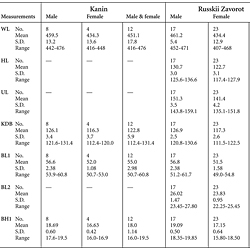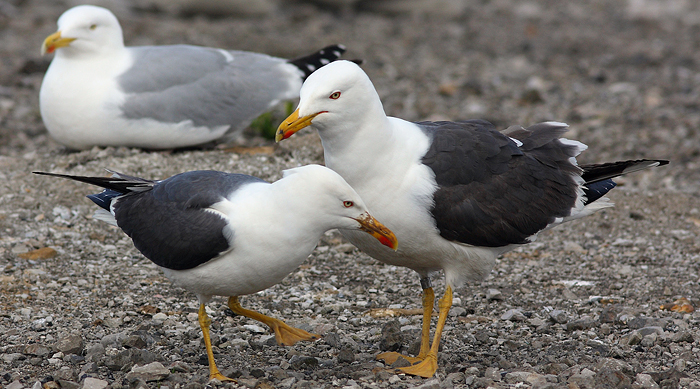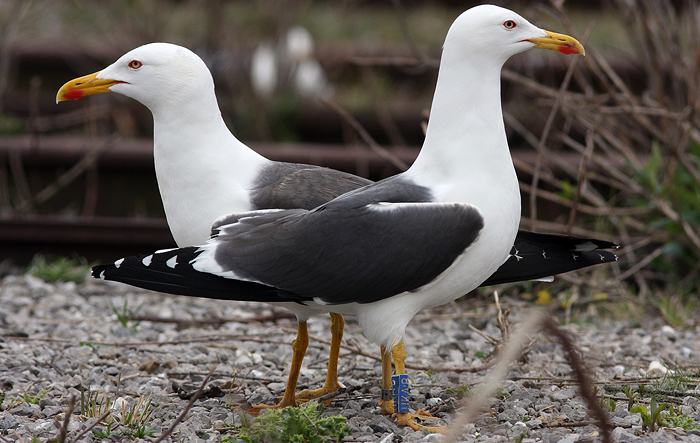 Heuglin's Gull (L. heuglini / antelius)
Heuglin's Gull (L. heuglini / antelius)
(last update:
Amir Ben Dov (Israel)
Chris Gibbins (Scotland)
Hannu Koskinen (Finland)
Mars Muusse (the Netherlands)
3cy heuglini: September
Below you will find a copy of Descriptive update on gull taxonomy: 'West Siberian Gull', by Valery A. Buzun published in British Birds 95 • May 2002 • 216-232. Most of the text below is a copy of that article, but now illustrated with many more birds and figures, and additional data from Dutch samples.
"I" in the text below refers to the original author Buzun. If any errors occur in this text, please let me know and mail to marsmuusseatgmaildotcom.
PART 1 - INTRO & MANTLE COLOUR
PART 2 - PRIMARY PATTERN & BARE PART COLORATION
PART 3 - MORPHOMETRIC & DIMORPHISM
PART 4 - BODY SIZE
PART 5 - PRIMARY MOULT
PART 6 - GEOGRAPHICAL VARIATION

The long-call display of 'West Siberian Gulls' Larus heuglini antelius, Russkii Zavorot peninsula, Malozemel'skaya
Tundra, Russia, June 1996. (picture: V.A. Buzun) The angle made by the slope of the head and neck with the plane of the back
varies from 30° to 50° in the third phase of the display. This is similar to the same phase of the Herring Gull
L. argentatus display. In the second phase of the long-call display, however, 40% of West Siberian Gulls from
Russkii Zavorot do not bend the head below the breast; instead, they lower the head only to the level of
the crop, in contrast to Herring Gulls.
Descriptive update on gull taxonomy: 'West Siberian Gull' - Valery A. Buzun
PART 3
Morphometric characters
 |
Table 4: Measurements of 'West Siberian Gulls' Larus heuglini antelius, from the Kanin Peninsula, Russkii Zavorot Peninsula and the Gulf of Ob, Russia. |
As noted earlier, the existing data on size measurements of antelius are insufficient for a comprehensive biometric analysis. Outside Russia, only 30 specimens exist in museums (Cramp & Simmons 1983), and not all of them can be assigned to antelius with any certainty, since most were collected outside the breeding range. The wintering areas of a number of dark-mantled taxa probably overlap.
The most complete collection of antelius skins is stored in the Zoological Institute in St Petersburg, Russia. These specimens have been only partially described biometrically, by Stegmann (1934) and by Yudin & Firsova (1988), neither of which detailed the methods used to obtain measurements. The lengths of the wing, bill and tarsus were analysed only on an elementary level, and for sample sizes which were diverse and variable. Yudin & Firsova (1988) did not clearly specify the borders of the breeding range of antelius, and in both cases there was no correction for known shrinkage of stored skins (see Barth 1967). Together, these factors have influenced the results reported in previous studies.
Sexual dimorphism
As significant differences in size between the sexes are known for argentatus, cachinnans and armenicus, the biometric data for antelius need also to be analysed separately for males and females. By a combination of skull measurements such as condylobasal length (combined head and bill), and bill length and depth, it is possible to sex live gulls reliably. It was, therefore, important to establish similar parameters for sexing antelius and heuglini. Consequently, I processed and dissected the specimens obtained on the Russkii Zavorot peninsula and in the northern Taimyr Peninsula.
It was found that significant numbers of females overlapped in measurements with males. In a sample of 23 females, two were heavy (930 g and 1,045 g), with very long wings (453 mm and 468 mm) and a large skull (122.5 mm and 121.4 mm). Before dissection, both were mistakenly thought to be males. The biometric data for one of these females exceeded the mean for both sexes (table 4). The short sternum, the large, long-billed head and the rather short legs made this female appear massive on the ground, and its long wings made it look large in flight, too. It was not possible to establish a method of sexing birds by weight. Three other females were heavy (1,025-1,055 g), but each had a short, delicate bill which allowed accurate sexing before post-mortem examination.

Lesser Black-backed Gull 7CY EA672341 / 440N April 27 & May 11 2013, Calais, NW France (Jean-Michel Sauvage). Metal ringed male, with smaller and more delicate partner (female). Ringed with colour-ring and metal, as pullus on June 27 2007, at "Umicore" Calais, NW France. For several years the red ring 440N could be read as well, but from 2012 it was lost and only metal ring left. Many recoveries from Morocco forthis bird.
All 17 males were accurately sexed by their external appearance, using male argentatus as a guide. Although there is overlap between males and females in each character, individual gulls can be sexed accurately by using a combination of characters. Of those caught on the Russkii Zavorot peninsula, 22% had a humerus length which fell in the overlap zone between males and females; similar overlap between the sexes was found in the condylobasal length (skull) in 10% of individuals and in the bill depth at the rear edge of the nostril in 5%.
=========================
The following formulae (DF = discriminant factor) permit 100% accuracy in the determination of males and females (see Materials and methods for definitions of measurement abbreviations). For males DF > 0, whereas for females DF < 0.
DF = (0.14 x KDB) + (1.03 x BH1) - 45.89 or
DF = (1.31 x BH1) + (0.32 x BL1) - 40.64 or
DF Z (0.83 x BH1) + (0.95 x BH3) - 31.02
=========================
It is hoped that these discriminant equations will be widely applicable, because geographical size variation is likely to be weak (see below).

Lesser Black-backed Gull 6CY HKAB May 04 2013, Calais, NW France (Jean-Michel Sauvage). Ringed as pullus on July 11 2008 at Zeebrugge (Voorhaven), West-Vlaanderen, Belgium (51°21'0''N 3°11'0''E). Female blue HKAB, in 2012 with male metal BLB L902113, but in 2013 with new, unringed partner. Note especially shape of head and bill.
 Heuglini 3cy September 29 2011, Ashdod, Israel. Picture: Amir Ben Dov.
Heuglini 3cy September 29 2011, Ashdod, Israel. Picture: Amir Ben Dov.